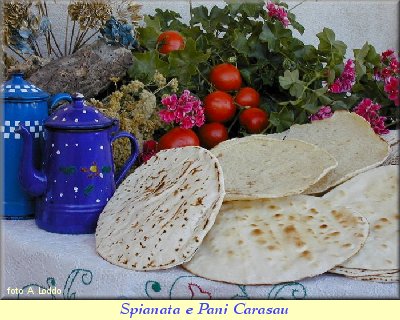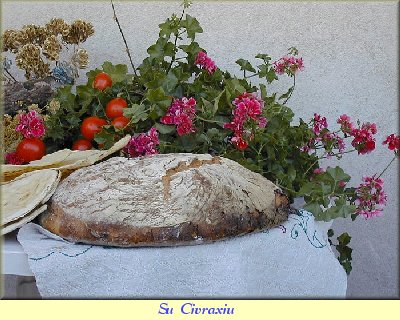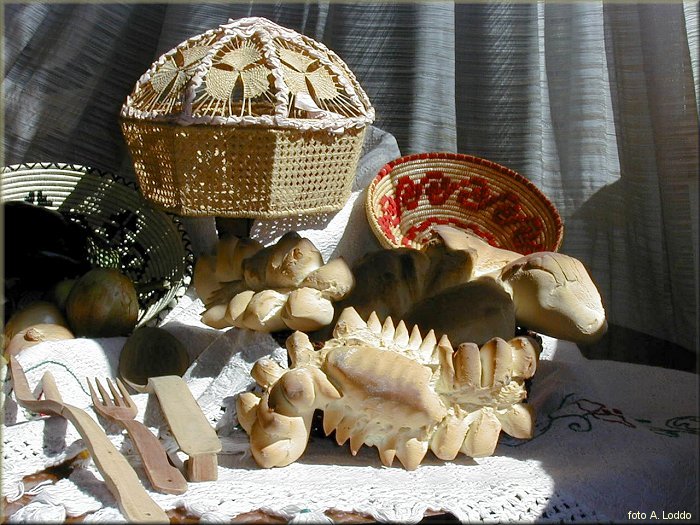The flavours and perfumes of our land that remain in the traditions and the memories of people….This should be a brief and hopefully delightful journey to discover the most ancient flavours and perfumes of Sardinian gastronomy.
The wheat.The age of introduction of wheat in our land is quite unknown but for sure it has been known for 9.000 years. It has been produced in great quantity and its quality is excellent.
The Sardinian wheat was cultivated and exported to
the main land in ancient times by the Romans, it was cleaned by slaves and the great quantity produced made Sardinia gain the name of "Italy's granary". Recently an ancient millstone used to grind the wheat has been found in the peninsula of Sinis, near Tharros, dated back to the Roman domination.
The flour obtained by grinding the wheat, was traditionally sift through particular tools "Is Tarazzus" grills made with hay. The different width grills determined the kind of product. The less valuable product: the bran "su poddini", was used mainly used to make a very poor bread for the animals feed. The durum wheat has three different sizes: the thick one "simbula grussa" used to make an oriental dish, the couscous, in Sardinian version: "sa fregula". The medium size, "sa simbula fini" is used to make normal bread and the very fine one "su scetti" is used to make special bread, the one for special occasions, or sweats "su pan'e festa"and "is durcerias". Our bread and its history. Wondering about further inland where the traditions and antique habits have survived to time and dominations, we may find that bread is still made as ages ago. The most ancient bread is “ Su Pistoccu”, made with wheat flour and water. Its name probably derives from the ancient baker corporations called “Pistores”. It’s a typical dry bread used, as in Middle East populations, as a plate to hold the food. Depending from the area where it’s produced it changes in consistency and shape. It originally comes from the centre of Sardinia but is now produced all over the island.  A very thin, crunchy and round bread is the “Carta da Musica” and a slightly more consistent one is the “Pani Carasau”. This kind of bread is cooked twice in the oven, the big bell shape oven made in bricks. Once it’s cooked it is divided in half and goes back into the oven to be completely dried out. The “Spianata”, a thicker and more tender bread was born a little later. With the years this kind of bread became bigger and rounder. The “Civraxiu” is a much bigger loaf of bread, its dimensions change from area to area, similar one is the “Moddizzosu”, they both have a thick crust and a very soft inside. The prince of breads is the white “kokkoi” that is worked much more than the others until the pastry becomes white, it’s a very special bread for special occasions. A very thin, crunchy and round bread is the “Carta da Musica” and a slightly more consistent one is the “Pani Carasau”. This kind of bread is cooked twice in the oven, the big bell shape oven made in bricks. Once it’s cooked it is divided in half and goes back into the oven to be completely dried out. The “Spianata”, a thicker and more tender bread was born a little later. With the years this kind of bread became bigger and rounder. The “Civraxiu” is a much bigger loaf of bread, its dimensions change from area to area, similar one is the “Moddizzosu”, they both have a thick crust and a very soft inside. The prince of breads is the white “kokkoi” that is worked much more than the others until the pastry becomes white, it’s a very special bread for special occasions.The “kokkoi” has a very thick paste and is worked in very different and skilful shapes, the most precious ones made with the scissors. The smaller the bread is the more precious it becomes. It’s the prince of breads! It accompanies all the important events in a mans life: from birth … to death. It usually celebrate all the religious events. The smallest ever known was the one used to celebrate Sant’Agata’s festivity (no longer in use), it was as small as a bean and was flung upon the houses roofs while praying and invoking the saints help against the damages caused by hail and lightnings. The “kokkoi” is still in use at the end of the suffrage mass, it is given to the people that have attended the mass. In this occasion its name is: “su pani de’is animas” (the bread of the souls). In occasions such as weddings it is shaped like interwoven circles or flowered garlands with little birds, then at Easter it is has the shape of a heart with an egg in the centre, or depending from the festivity celebrated it can have the strangest shapes, from a bunch of grapes to a little cart with fruit in it. Several shapes like birds and little puppets made in “Pan’e Saba” a sweat bread with must in it were given to the children in special occasions or when mothers were baking the big loafs of “Pan’e Saba”. At first bread in Sardinia was the main food and it was gradually improved to make it become more complete introducing new ingredients in it such as olives, potatoes, cottage cheese, little chips of pork meat (the parts usually used to make lard). After the XVII century, with the introduction of tomatoes, new dishes made with bread were invented, such as: “sa prazzira” (salty cakes) that could be with “tamatta e perdingianu” (tomato and aubergine) and later on also “sa panara de anguiddas” made with eels or the one with “angioni” lamb. These “panare” are like a high pizza with a pizza top sowed on and a decorating braid around it, inside they can have just about anything, they are very similar to pies. Wheat has always been at the base of the Sardinian cuisine. “Is malloreddus” are the typical Sardinian pasta made like little shells and “sa fregula” very similar to couscous. There are also “Is culungiones”, most similar to “ravioli” that have potatoes, cheese, cottage cheese or vegetables inside. A typical sweat is the “Seadas”, like a big “ravioli” with sour cheese inside, it’s fried and honey is added to it before serving.
OUR RECIPES WITH BREAD “Su pani Guttiau” INGREDIENTS: Carta da musica, olive oil, salt and a little twig of rosemary. Spread the olive oil over the sheet of Carta da musica using the rosemary as a brush, you can also leave a little piece in the oil to soak. You can either salt the oil or add salt before or after the heating. Heat the oven at a high temperature and put the Carta da musica in till it browns. It’s then ready to serve. “Su pani Pistoccu” INGREDIENTS: Pani carasau, new pecorino cheese, Sardinian salted olives, wild fennel twigs. Put the pecorino cheese cut into thick slices to roast on the fire (this is the traditional way), once it’s roasted lay it on the sheets ofPani carasau with the salted olives and the twigs of wild fennel.  “Su pani Frattau” “Su pani Frattau”INGREDIENTS (x 1 person): 3 sheets of Pani Pistoccu, tomato sauce, grated pecorino cheese, an egg, salt. Must serve this dish as soon as it’s prepared to avoid the bread from soaking to long. Put a pan with some salty water on to heat, when the water is nearly boiling put a piece of bread into it and lay it immediately on the serving plate, spray it with some tomato sauce and grated pecorino, then pass on to the following piece to be layed over the first one and so on till you finish the bread. Each sheet of bread must be cut into 4 pieces so that they can fit onto a normal serving plate. In the same boiling water put an egg to boil that must be taken out as soon as the egg white thickens, break it and put it on the last slice of bread with sauce and pecorino. The dish is now ready. Sometimes each single piece of bread is rolled and eaten with the hands. “Su pani Abbattiau” INGREDIENTS: Carta da musica, flour, milk, egg, honey, olive oil, salt. Mix the flour, add a little salt, the egg and the milk into a cream Prepare little pieces of Carta da musica and tip them into the mixture, fry them into boiling oil until golden, drain them and lay them on the serving plate, pour some honey over them and serve.
“Su pani Untiau” INGREDIENTS: a medium size Civraxeddu, olive oil, salt and pepper. Divide the Civraxeddu in half so as to have the bottom part and the top part in a whole piece, with a knife cut the soft part of the bread lengthwise so that you form a design in squares and put the two parts of the bread (crust on the bottom) into the hot oven. When they brown pour the oil over the two tops and add salt and pepper. It must be eaten still hot. “Spianata Mediterranea” INGREDIENTS: a Spianata per person, little tomatoes, new pecorino cheese, Sardinian olives, olive oil and salt. Slice the tomatoes and the cheese into thin slices, lay them on the Spianata spread a little oil and salt over the tomatoes and bread (better if not on the pecorino) and… it’s ready ! It cen be eaten as it is or heated in the oven till the cheese melts. “Mazzamurru” INGREDIENTS: tomato sauce made with fresh tomatoes, slices of stale bread, broth, grated pecorino, onion, garlic, olive oil and salt. Brown a clove of garlic in a spoon of olive oil and take it out of the pan, put in its place a finely chopped onion until it browns. Add a ladle of broth and the tomato sauce and salt if necessary. Let it all cook for a few minutes. Finally add the stale bread cut into about 1 cm thick slices and let them boil for a few minutes before putting off the fire and leaving it to soak well. Before serving sprinkle a good amount of grated pecorino over the dishes.
Translated by Rossana Ornano
 Su pistoccu Su pistoccu
Bread of Sardiniaby Annamaria Loddo | |
| 
Nessun commento:
Posta un commento